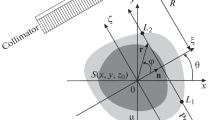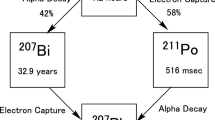Abstract
A method was set up for single-photon emission tomographic (SPET) quantification of radioactivity concentration in small anatomical structures. The method is based on the theoretical model proposed by Kessler et al. (J. Comput Assist Tomogr 1984; 8: 514–522) describing the effects of spatial resolution (partial volume effect and spillover) on the quantification of radioactivity concentration in small spherical objects. The model was validated here in SPET, by phantom experimental measurements, in relation to object size and source/background contrast. Good agreement was found between model-predicted and SPET-measured radioactivity concentration ratios in hot spots in hot background experiments. Accuracy of the method was assessed for comparison of model-corrected and true radioactivity concentration ratios and was found to be within 8.5% over the full range of object size (9.4–36.5 mm). The good agreement found indicates that the model can be used to correct for partial volume effect and spillover in specific clinical situations, when the anatomical structure under study can be approximated by a sphere of known size (e.g. neuroreceptor and tumour studies). The method was applied to a representative SPET monoclonal antibody patient study for the quantification of radioactivity concentration in ocular melanoma.
Similar content being viewed by others
References
Burkard R, Kaiser KP, Wieler H, Klawki P, Linkamp A, Mittelbach L, Goller T. Contribution of thallium-201-SPECT to the grading of tumorous alterations of the brain.Neurosurg Rev 1992; 15: 265–273.
Paganelli G, Magnani P, Zito F, et al. Pre-targeted immunodetection in glioma patients: tumour localization and single-photon emission tomography imaging of [99mTc]PnAO-biotin.Eur J Nucl Med 1994; 21: 314–321.
Nadeau SE, Couch MW, Devane CL, Shukla SS. Regional analysis of D2 dopamine receptors in Parkinson's disease using SPECT and iodine- 123-iodobenzamide.J Nucl Med 1995; 36: 384–393.
Laurelle M, Wallace E, Seibyl JP, Baldwin RM, Zea-Ponce Y, Zoghbi SS, Neumeyer JL, Charney DS, Hoffer PB, Innis RB. Graphical, kinetic, and equilibrium analysis of in vivo [123I]β-CIT binding to dopamine transporters in healthy human subjects.J Cereb Blood Flow Metab 1994; 14: 982–994.
Kalofonos HP, Pawlikowska TR, Hemingway A, et al. Antibody guided diagnosis and therapy of brain gliomas using radiolabeled monoclonal antibodies against epidermal growth factor receptor and placental alkaline phosphatase.J Nucl Med 1989; 30: 1636–1645.
Gilland DR, Jaszczak RJ, Turkington TG, Greer KL, Coleman RE. Volume and activity quantification with Iodine 123 SPECT.J Nucl Med 1994; 35: 1707–1713.
Kessler RM, Ellis JR, Eden M. Analysis of emission tomographic scan data: limitations imposed by resolution and background.J Comput Assist Tomogr 1984; 8: 514–522.
Genna S, Smith AP. The development of ASPECT, an annular single crystal brain camera for high efficiency SPECT.IEEE Trans Nucl Sci 1988; NS-35: 654–658.
Zito F, Savi A, Fazio F. CERASPECT: a brain-dedicated SPECT system. Performance evaluation and comparison with the rotating gamma camera.Phys Med Biol 1993; 38: 1433–1442.
Bailey D, Zito F, Gilardi MC, Savi A, Fazio F, Jones T. Performance comparison of a state-of-the-art-neuro-SPECT scanner and a dedicated neuro-PET scanner.Eur J Nucl Med 1994; 21: 381–387.
Chang LT. A method for attenuation correction in radionuclide computed tomography.IEEE Trans Nucl Sci 1978; 25: 638–643.
Oppenheim BE. Scatter correction of SPECT.J Nucl Med 1984; 25: 928–929.
Bomanji J, Nimmon CC, Hungerford JL, Solanki K, Granowska M, Britton KE. Ocular radioimmunoscintigraphy: sensitivity and practical consideration.J Nucl Med 1988, 29: 1031–1044.
Paganelli G, Magnani P, Zito F, et al. Three-step monoclonal antibody tumor targeting in CEA-positive patients.Cancer Res 1991; 51: 5960–5966.
Spinks T, Guzzardi R, Bellina CR. Measurement of resolution and recovery in recent generation positron tomographs.Eur J Nucl Med 1989; 15: 750–755.
Bendriem B, Dewey SL, Schlyer DJ, Wolf AP, Volkow ND. Quantitation of the human basal ganglia with positron emission tomography: a phantom study of the effect of contrast and axial positioning.IEEE Trans Med Imaging 1991; 10: 216–222.
Hoffman EJ, Huang SC, Phelps ME. Quantitation in positron emission computed tomography: I. Effect of objects size.J Comput Assist Tomogr 1979; 3: 299–308.
Mazziotta JC, Phelps ME, Plummet D, Kuhl DE. Quantitation in positron emission computed tomography: 5. Physical-anatomical effects.J Comput Assist Tomogr 1981; 5: 734–743.
Muller-Gartner HW, Links JM, Prince JL, Bryan RN, McVeigh E, Leal JP, Davatzikos C, Frost JJ. Measurement of radiotracer concentration in brain gray matter using positron emission tomography: MRI-based correction for partial volume effects.J Cereb Blood Flow Metab 1992; 12: 571–583.
Yu DC, Huang SC, Grafton ST, Melega WP, Barrio JR, Mazziotta CJ, Phelps ME. Methods for improving quantitation of putamen uptake constant of DOPA in PET studies.J Nucl Med 1993; 34: 679–688.
Kojima A, Matsumoto M, Takashi M, Hirota Y, Yoshida H. Effect of spatial resolution on SPECT quantification values.J Nucl Med 1989; 30: 508–514.
Alaamer AS, Fleming IS, Perring S. Evaluation of the factors affecting the accuracy and precision of a technique for quantification of volume and activity in SPECT.Nucl Med Commun 1994; 15: 758–771.
Videen TO, Perlmutter JS, Mintun MA, Raichle ME. Regional correction of positron emission tomography data for the effects of cerebral atrophy.J Cereb Blood Flow Metab 1988; 8: 662–670.
Kuikka IT, Tiihonen J, Bergstrom KA, Karhu J, Hartikainen P, Viinamaki H, Lansimies E, Lehtonen J, Hakola P. Imaging of serotonin and dopamine transporters in the living human brain.Eur J Nucl Med 1995; 22: 346–350.
Author information
Authors and Affiliations
Rights and permissions
About this article
Cite this article
Zito, F., Gilardi, M.C., Magnani, P. et al. Single-photon emission tomographic quantification in spherical objects: effects of object size and background. Eur J Nucl Med 23, 263–271 (1996). https://doi.org/10.1007/BF00837624
Received:
Revised:
Issue Date:
DOI: https://doi.org/10.1007/BF00837624




